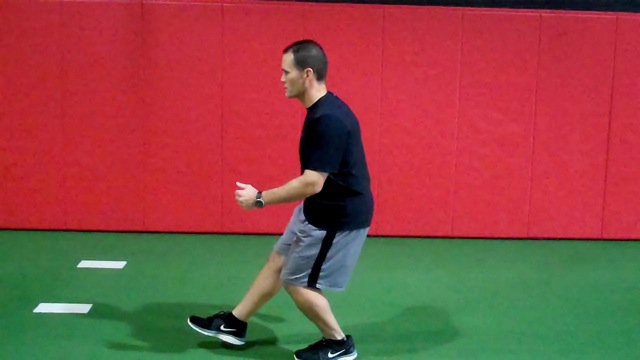
Runners are often sidelined by overuse injuries. One of the primary reasons is they move poorly. This is compounded by the fact that running entails single leg stability, and most runners have asymmetries. Mastering neuromuscular control of their body is paramount if they want to add mileage and stay healthy. In light of this, I work extensively with them on single leg bodyweight exercises.
Coaching them to have a tight (still) core while performing smooth single leg exercises requires sufficient glute activation as well as inner core stability to maintain proper alignment. One such exercise I use to train proper frontal plane stability at the hip and knee is a lower extremity anterior to posterior reach.
Execution:
Coaching them to have a tight (still) core while performing smooth single leg exercises requires sufficient glute activation as well as inner core stability to maintain proper alignment. One such exercise I use to train proper frontal plane stability at the hip and knee is a lower extremity anterior to posterior reach.
Execution:
|
Return to the upright position and move continuously to the posterior reach (pictured below, left) by reaching the non-stance foot (toes) as far back as possible again just before the stance heel starts to come up or there is a loss of stability in the frontal plane. Pause and then move back to the anterior reach again (pictured right). The exercise should flow smoothly with a subtle pause at the end of each reach (no pause at the top between reaches).
The goal is to performa all repetitions with no loss of balance or touching the moving foot to the floor. Perform 10 repetitions and repeat 2-3 times on each side.
 | |
Regression:
In some cases, it will be necessary to break this exercise into anterior reaches and posterior reaches prior to linking them. Posterior reaches are easier as they allow for more posterior chain activation, whereas anterior reaches require more quadriceps work and shift the center of mass further backward making balance more challenging. Keep this in mind and teach accordingly aiming for strict form versus greater reaching distance initially.
Application:
This exercise is indicated for any runner seeking better performance and reduced injury risk. It aims to improve ankle mobility, core and hip/knee stability, frontal plane control and proper reciprocal neuromuscular patterning. I routinely use it for runners dealing with patellofemoral issues related to hip weakness and poor quad control. Learning to control and reduce dynamic valgus moments in single leg stance is critical for injury prevention.
It is also an effective exercise for work on kinetic linking between the shoulders, torso and hips to reduce energy leaks and improve running form and efficiency.
In addition to runners, it can be implanted for any athlete who needs to resolve imbalances and improve running performance/mechanics. Do not sacrifice form for distance, and at no time should this exercise cause knee pain.
Brian Schiff, PT, OCS, CSCS, is a licensed physical therapist, respected author and fitness professional. Currently, he serves as the supervisor at the Athletic Performance Center in Raleigh, NC. Brian presents nationally at several professional conferences and seminars on injury prevention, rehab and sport-specific training. For more cutting edge training information, subscribe to his monthly Training & Sports Medicine Update at www.BrianSchiff.com.
Application:
This exercise is indicated for any runner seeking better performance and reduced injury risk. It aims to improve ankle mobility, core and hip/knee stability, frontal plane control and proper reciprocal neuromuscular patterning. I routinely use it for runners dealing with patellofemoral issues related to hip weakness and poor quad control. Learning to control and reduce dynamic valgus moments in single leg stance is critical for injury prevention.
It is also an effective exercise for work on kinetic linking between the shoulders, torso and hips to reduce energy leaks and improve running form and efficiency.
In addition to runners, it can be implanted for any athlete who needs to resolve imbalances and improve running performance/mechanics. Do not sacrifice form for distance, and at no time should this exercise cause knee pain.
Brian Schiff, PT, OCS, CSCS, is a licensed physical therapist, respected author and fitness professional. Currently, he serves as the supervisor at the Athletic Performance Center in Raleigh, NC. Brian presents nationally at several professional conferences and seminars on injury prevention, rehab and sport-specific training. For more cutting edge training information, subscribe to his monthly Training & Sports Medicine Update at www.BrianSchiff.com.
 Begin standing on one leg focusing on an erect posture. Next, brace or tighten the core musculature intentionally. Proceed to reaching the heel of the non-stance leg forward while keeping the stance heel flat on the ground and the knee of the stance leg tracking toward the second toe. Pause briefly prior to the heel coming up or losing control (internal rotation/adduction of the stance leg).
Begin standing on one leg focusing on an erect posture. Next, brace or tighten the core musculature intentionally. Proceed to reaching the heel of the non-stance leg forward while keeping the stance heel flat on the ground and the knee of the stance leg tracking toward the second toe. Pause briefly prior to the heel coming up or losing control (internal rotation/adduction of the stance leg).














